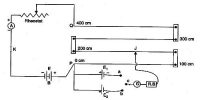In 1834, a French scientist Peltier discovered that when the electric current is passed through a circuit consisting of two dissimilar metals, heat is evolved at one junction and absorbed at the other junction. This is called Peltier effect. Peltier effect is the converse of Seebeck effect.
Fig: Peltier effect
In a Cu-Fe thermocouple, at the junction 1 (Fig: a) where the current flows from Cu to Fe, heat is absorbed (so, it gets cooled) and at the junction 2 where the current flows from Fe to Cu heat is liberated (so, it gets heated). When the direction of the current is reversed (Fig: b) junction 1 gets heated and the junction 2 gets cooled. Hence Peltier effect is reversible.











